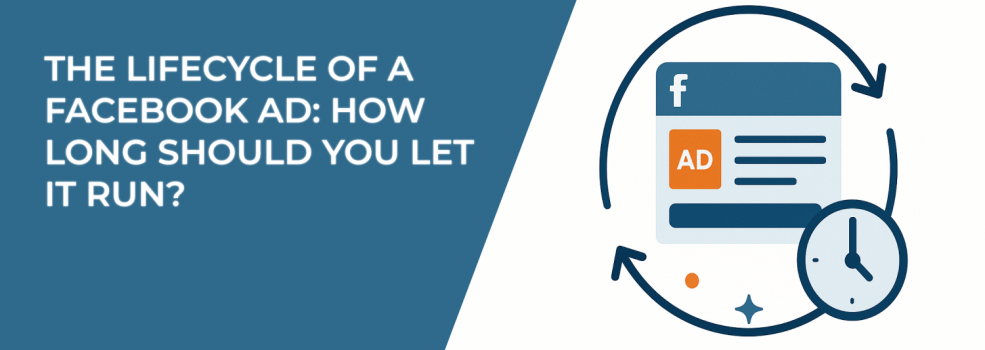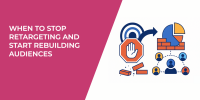Understanding when to let a Facebook ad run and when to pause it is one of the most underrated skills in paid media. Let it run too long, and you start burning budget. Cut it too soon, and you lose the chance to learn what actually works.
This article breaks down the full Facebook ad lifecycle — from launch to decision point — and shows you how to optimize performance at every stage. If you’re tired of guessing when to pull the plug, keep reading.
Phase 1: The Learning Phase (Day 1 — 3)
Facebook ads begin in a learning phase. That means the algorithm is still testing who to show your ad to, what placement performs best, and how your audience behaves.

CTR drops or flatlines, CPA rises, and frequency steadily increases over time — clear signs that the ad is fatiguing or underperforming and may need to be refreshed, paused, or killed.
What to expect during learning:
-
Inconsistent results — You may see fluctuating cost-per-acquisition (CPA), click-through rates (CTR), or impressions. Don’t panic. The algorithm is still figuring out delivery.
-
Low impressions or weird delivery — Ads might not deliver smoothly as Facebook tests combinations.
-
The campaign feels fragile — You might be tempted to make quick edits. Hold off.
Minimum requirements for judging performance:
-
Let the ad reach 50 optimization events (e.g., purchases, leads, or clicks). This is what Meta needs to properly calibrate the campaign.
-
Wait at least 3 full days, assuming your daily budget allows enough volume to collect statistically relevant data.
If you’re seeing the "Learning Limited" warning, review this guide on how to finish the Facebook learning phase quickly.
Phase 2: Optimization and Scaling (Day 4 — 10+)
Once the learning phase is complete, your ad will settle into its actual performance.
This is the window where you evaluate whether it’s time to scale, test variations, or let it keep running as-is.
Performance indicators to track:
-
Cost per result: Is the cost aligned with your KPI targets? If not, it may be time to tweak creative, placement, or audience.
-
Click-through rate (CTR): A low CTR indicates weak creative or message-audience mismatch. Aim for 1% or above.
-
Frequency: This shows how often your audience sees the same ad. Once it climbs past 2.5 or 3, performance usually drops.
Tip: A good frequency cap for most cold traffic campaigns is 2.5 to 3. Once you cross that line, performance usually dips.
If results are strong and consistent — scale gradually. Increase budget by no more than 20% every couple of days to avoid disrupting the algorithm. You can also rotate in creative variations to test for fatigue or tap into new segments.
But if your ad is failing, here’s how to troubleshoot:
Phase 3: Fatigue and Decline (Usually after 7 — 20 days)
Even your best ads will eventually wear out. Performance can decline because of audience burnout, creative fatigue, or market timing.
Look for these warning signs:
-
CTR starts to drop below 1% — This often means the ad is no longer resonating.
-
Frequency rises past 3.5 — Your audience is seeing the same message too often.
-
Cost per result keeps climbing with no clear reason — If ROAS dips despite no other changes, it's time to reassess.
That doesn’t mean you need to kill the whole campaign. But you do need to refresh your creative or segment your audience better to keep performance stable. Read how to spot and fix ad fatigue for more tips.
When to Kill, Pause, or Adjust an Ad
Sometimes a Facebook ad just isn’t fixable. The offer may be weak, the audience too broad, or the creative unconvincing. In those cases, it’s better to pull out early and rebuild from scratch.
| ❌ Kill | ⏸️ Pause | 🔧 Adjust |
|---|---|---|
| 5+ days and still underperforming | Testing new creative soon | CTR good, but ROAS low |
| No improvement after edits | Offer expired or seasonal | Frequency rising in small audience |
| Stuck in Learning Limited | Slightly under goal, needs testing | One metric weak, others stable |
Here’s a quick cheat sheet:
Kill an ad if:
-
It’s been 5+ days and performance is far below your targets. If you’ve gathered enough data, don’t wait longer.
-
You’ve made optimizations (copy, image, targeting) and seen zero improvement.
-
Your ad is stuck in "Learning Limited" with no real path out. If you’ve already simplified the structure and budget, don’t keep wasting money.
Pause an ad if:
-
It’s borderline performance, but you want to run a creative or audience test before turning it off completely.
-
You’re planning a refresh — New copy or visuals are on the way.
-
It’s seasonal or time-sensitive, and the offer expired or is no longer relevant.
Adjust an ad if:
-
Your CTR is strong, but ROAS is dropping — Tweak targeting, placements, or post-click experience.
-
The audience is small, and frequency is rising fast — Consider expanding targeting.
-
One metric is weak, but others look stable — Diagnose what’s holding it back before killing the whole thing.
Still unsure when to make the call? Read this guide on when to pause, merge, or kill Facebook campaigns.
Bonus: What Happens When You Pause or Restart a Campaign?
Many advertisers are afraid to pause ads — but sometimes it’s necessary. Just know that when you restart a campaign, Meta may treat it like a new ad, which can reset your learning phase.
However, not every edit restarts learning. Here’s what happens when you pause and restart Facebook campaigns.
Use this tactic wisely when you're:
-
Refreshing creative mid-campaign — If performance is slowing down, a pause-and-refresh can reset attention.
-
Adjusting for seasonality — Turning off and back on during promotions is normal.
-
Testing a new offer or price point — Just be prepared for short-term instability.
Final Thoughts: Let the Metrics Lead
There’s no universal timeline for every Facebook ad. Some hit in 48 hours. Others take a week to reveal their true potential.
The key is not to rush. But don’t stay emotionally attached to underperforming ads either. Your numbers should guide your next move.

